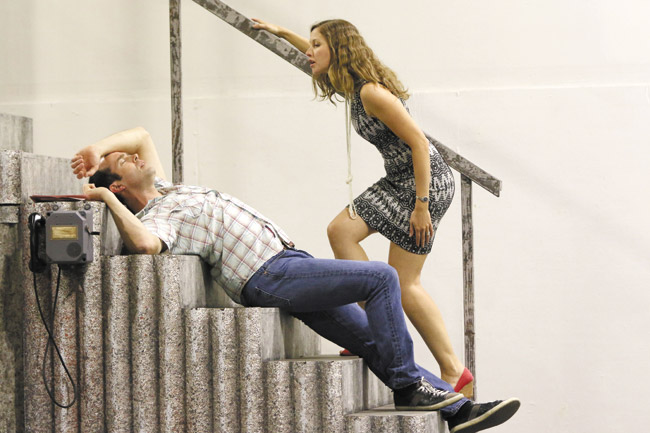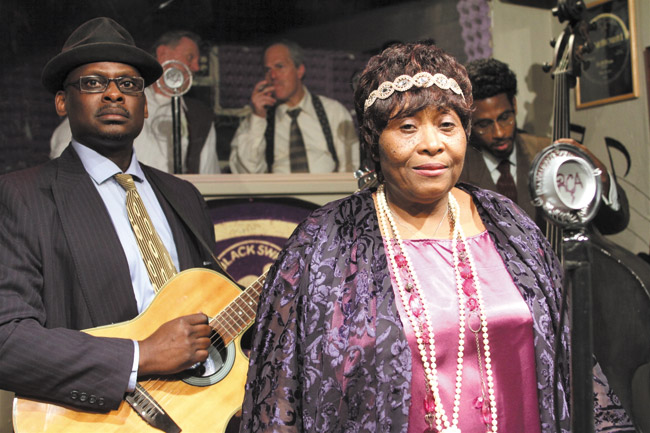‘Ma Rainey’s’ Rips Into The Gut
Ma Rainey’s Black Bottom at TAG is reason to celebrate community theater in Hawaii. It’s not only theater about the African-American experience, which you don’t see on stage often in Hawaii, but it’s straight up, powerful theater. An electric charge suffuses dramatic work when the group is unified through a cause that transcends the individual. The four lead men, who we see bickering, storytelling and engaging in humorous jousting, give bountifully of themselves so that Ma Rainey’s resonates with purpose.
This work, written by August Wilson and directed by Lillian Jones, is set in a 1927 Chicago music studio, evoked by a split-level set with vintage mics and a sound room. Toledo (Curtis Duncan), Cutler (Michael Edwards), Slow Drag (Marc Cooper) and Levee (Jason Quinn) are a quartet of musicians striving to do better than just get by in a white man’s world. We see these four men at the forefront of the stage, while their white bosses, Sturdyvant (Ron Heller) and Irvin (Alan Picard) omnisciently run the controls from their sound room perch. Heller is the cigar-chewing head honcho, and Picard does his part to a T as the obsequious groveler, caught between tightfisted Sturdyvant and the musicians who demand their fair share.
Then there’s Ma Rainey herself, played by Micki Fine as black musical royalty. One of her popular songs is ‘Black Bottom,’ hence the title. She’s the one paving the way, standing up to The White Man who is content with buying up negro songs at rockbottom prices and having whites record them.
But the bulk of the action takes place between Toledo and Levee. The first waxes philosophical about the dire straits for blacks, while the latter is so fiery, so determined to rise above the muck he’s been wading in, whatever the cost, that he’s on the verge of spontaneous combustion. Attacking the same problem in opposite ways pits Toledo and Levee against each other in a beautifully choreographed boxing match of emotions, but it’s not each other that’s the problem. It’s that these sturdy, capable men have been reduced to rats scrambling on top of each other, trying to escape from a hole. Try watching Levee’s monologue at the end of act one without feeling a vise on your heart.
Meanwhile, Cutler is a wise and serious fella who tames the studio mood with anecdotes and intellect, while Slow Drag’s likable vibe is a moderating force.
Duncan’s son, Kaleb Fitzsimmons, does a fine job as a stuttering, young relative of Ma’s, and Katrina McIntosh is eye-catching as the sultry and curvaceous object of some of Levee’s fire. Rounding out the cast is Kevin Borras as a policeman who’s having a tussle with Ma when Ma first appears onstage, but there ain’t no coming out on top against this tide-changing powerhouse.
On the topic of race relations, the attitude can get very, well, black and white, but Ma Rainey’s Black Bottom fleshes out the discussion and delivers depth and layers worthy of discussion.
Expect to leave haunted by Duncan’s and Quinn’s spitfire rage against the cosmic tilt that has left them dangling desperately close to the edge.
the TICKET stub
MA RAINEY’S BLACK BOTTOM
When: Through March 29
Where: TAG’s Brad Powell Theatre
Cost: $14-$25
More Info: 722-6941, taghawaii.net
ALSO SHOWING
Lady Of Opera

Vale Rideout as Davey, a sailor who falls for what he believes is a woman named Diana (Rachel Schutz). Photo by Cory Lum
Opera is making itself accessible to the masses by bringing its latest production, Siren Song, into Kakaako (March 20-29, 596-7858, hawaiiopera.org). The true story about a sailor scammed into falling in love with a woman who doesn’t actually exist is an all-too-familiar trope these days. Playing that mystery inamorata is Welsh-born soprano Rachel Schutz. You might have seen her and pianist husband Jonathan Korth playing recitals and concerts around the Island in the past six years that they’ve lived here, but she’s generally so busy singing opera in California, Japan, China and Korea that this production is her HOT debut, and she’ll be following it up as Sweeney Todd’s daughter in HOT’s next production. Both roles are new to Schutz.
“I’m a big proponent of contemporary music,” says Schutz, describing what drew her to Siren Song.
Plus, she’s all about moving the contemporary chamber opera from its usual Blaisdell setting to an intimate warehouse. As for Sweeney Todd? For someone who performed in musicals while growing up, Sweeney Todd — a Sondheim musical with operatic qualities — suits her swimmingly. Appearing in the two shows gives Schutz a chance to enjoy being home, away from her on-the-road fare of hotels and restaurants.
There’s a question to be begged. How do you portray someone who doesn’t exist? Schutz responds that her appearance onstage much of the show will serve as a visual representation for the audience’s imagination.
“I do a lot of character study before I go into a role, imagining what their history is, what their character is like. And even inventing some things that are not in the score, just to give the character more context,” she notes. “With this character (Diana), I can really invent anything because she is imaginary. It’s fun to have that flexibility.”
“In Sweeney Todd, my character (Johanna) is quite a damaged girl. She has had a difficult childhood, being abducted by the judge and locked away in his house her whole life, but she’s very innocent. It’s a fun contrast from Siren Song, because while Diana is also sweet and kind, there’s the undercurrent of something else going on, of deception, that we’re playing up in how we’re staging it. So, there’s an actually naive girl (Johanna) and then this imaginary person (Diana) who is very complex.”
Siren Song’s staging is a novel take on Jonathan Dove’s (who will attend the show) score that calls for Diana to sing offstage at times. Being in sight aids the minimalist approach of the production, and says Schutz, “Diana becomes more of a real person, so that the audience is deceived just as much as the character.”
Minimalist by no means translates as stark, notes Schutz. Wall projections will set the ambience of a sailor at sea, while reflecting his inner world.
“It will be very visually exciting,” says Schutz. “The projections will be haunting images of ideas — of this imaginary woman, and images of water to emphasize the navy aspect.”
Moreover, seating in the realm of 400 people (rather than 2,000 at Blaisdell), will mean the audience is in a more personal space with the actors, with a much closer view of movement and facial expression. For anyone who hasn’t given opera a try lately, the cozy location and trendy subject might be just the moment for a revisit.






